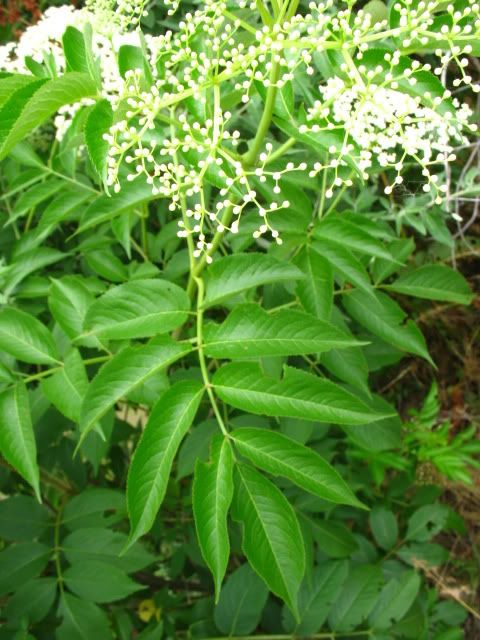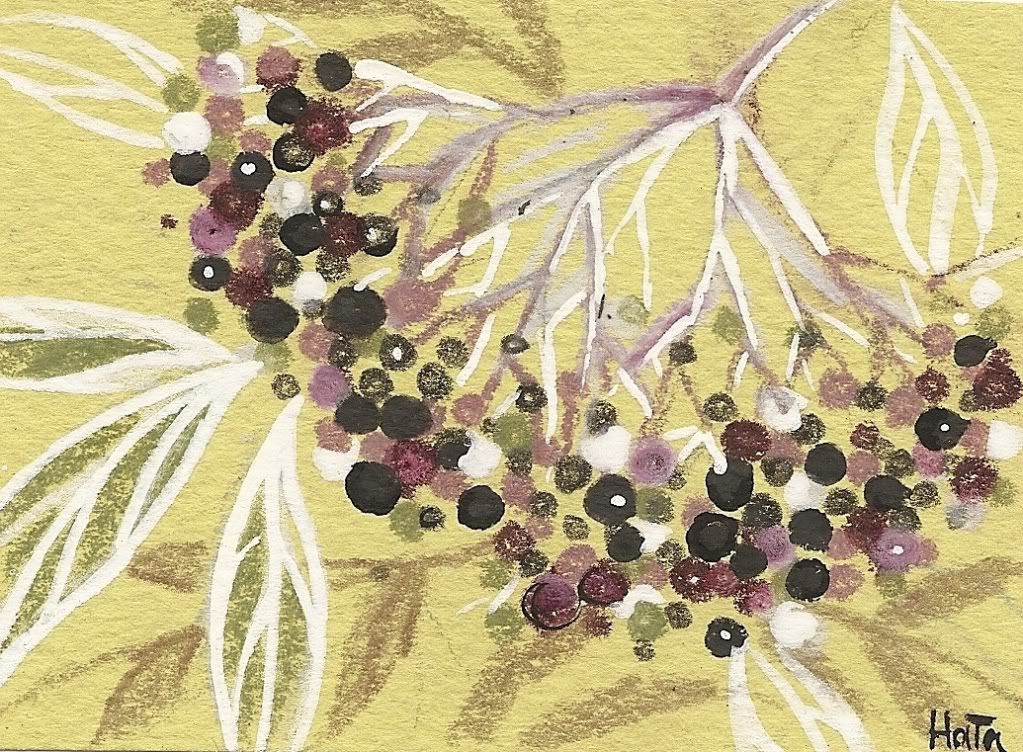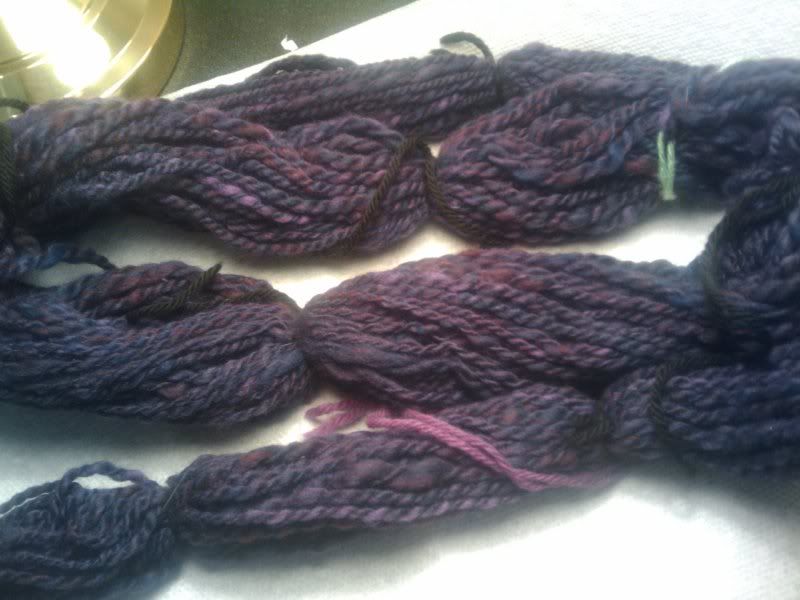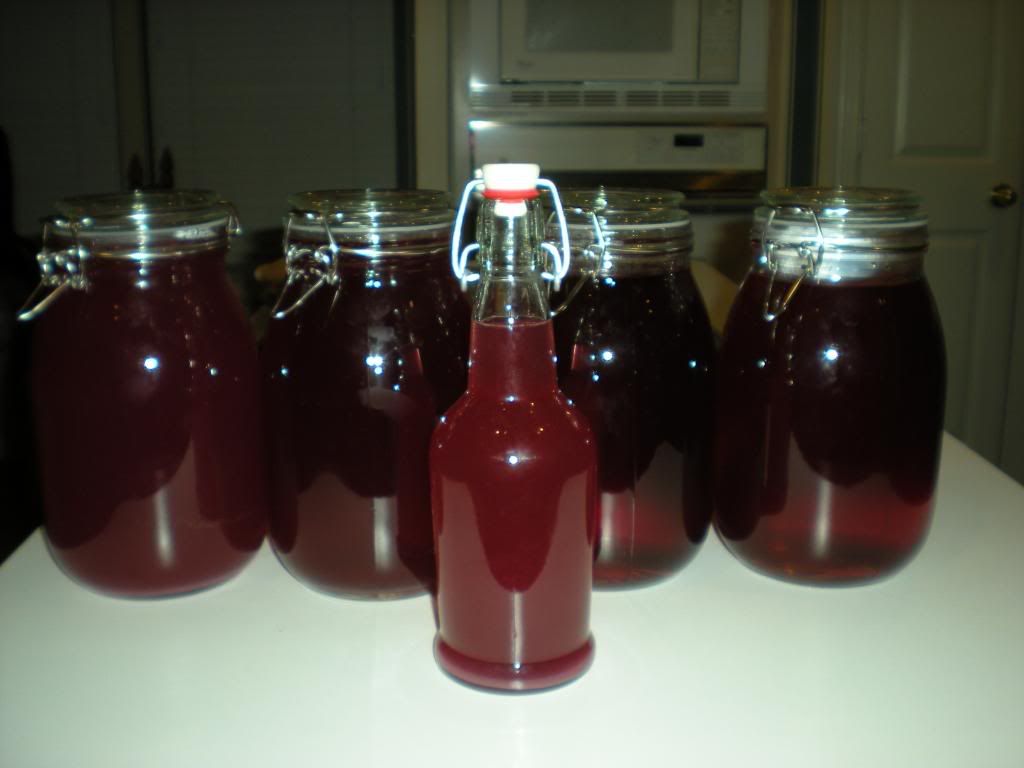
Elderberry
Sambucus canadensis
The American elder (canadensis) , also known as Elderberry, is small tree that grows to 12 feet and is native to North America. The European elder (nigra) grows to 30 feet, is found throughout Europe, Asia, North Africa, and has been naturalized in the United States. The tree has been called "the medicine chest of the common people.
The flowers, leaves, berries, bark and roots have all been used in traditional folk medicine for centuries. The fruits have been used to make elderberry wine, and when cooked, can be used in pies and jams. The berries contain more vitamin C than any other herb except rosehips and black currant.

The elder also has a rich background of cultural superstitions. In the Middle Ages legends held that tree was home to witches and that cutting down one would bring on the wrath of those residing in the branches.
The Russians and the English believe that elder trees ward off evil spirits and it was considered good luck to plant a tree near your home. Sicilians think that sticks of elder wood can kill serpents and drive away thieves.
This herb has a long history dating beyond the stone ages. Egyptians discovered that applying its flowers improved the complexion and healed burns. Many early Indian tribes used elderberry, and its variants, in teas and other beverages. In the 17th century the British often drank home made wine and cordials that was thought to prolong life and cure the common cold.
The berries from the elder contain a considerable amount of vitamins A, B and C, as well as flavonoids, sugar, tannins, carotenoids and amino acids. Warm elderberry wine is a remedy for sore throat, influenza and induces perspiration to reverse the effects of a chill. The juice from the berries is an old fashioned cure for colds, and is also said to relieve asthma and bronchitis.

Infusions of the fruit are beneficial for nerve disorders, back pain, and have been used to reduce inflammation of the urinary tract and bladder. Raw berries have laxative and diuretic properties, however the seeds are toxic and may induce vomiting and nausea. Elderberries are edible when cooked.
Elder leaves contain the flavonoids rutin and quercertin, alkaloids, vitamin C and sambunigrin, a cyanogenic glucoside. Fresh elder leaves also contain hydrocyanic acid, cane sugar, invertin, betulin, free fatty acids, and a considerable quantity of potassium nitrate. Elder flowers and elder flower water have been used in a variety of ways topically and as a tonic mixture.
Elder flowers are a mild astringent and are used in skin washes to refine the complexion and help relieve eczema, acne and psoriasis. Flower water makes a soothing gargle and when strained makes an excellent eye wash.
The leaves and flowers are a common ingredient in ointments and poultices for burns and scalds, swelling, cuts and scrapes. Infusions and preparations with the blossoms combined with other herbs have also been used to quicken recovery form the common cold and flu.
Parts Used: Bark, leaves, flowers, berries.
Common Use: Topically for infections, inflammations and swelling. As a wash for skin healing and complexion purification. As a tea and cordial to sooth sore throats, speed recovery from cold and flu and relieve respiratory distress. Cooked and used in jams and conserves.
Care: Prefers sandy or loamy soil rich in humus and nitrogen. Full sun or partial shade
Medicinal Uses of Elderberry Plants
Elderberry plants have been used for generations by the native people of the Pacific Northwest as both powerful medicine and vitamin-packed food supplements. The blue elderberry is found primarily on the eastern side of the Cascade Mountains, along roadsides running next to rivers and streams. The red elderberry finds the western side of the mountains to be a more hospitable place to reside. You will notice this luscious plant glowing red in forests and along shady roadsides late in the summer.
Nowadays, due to ease of travel, people generally use the blue elderberry for most of their needs, though the red elderberry was a highly useful and important source of food and medicine to the native people of the Northwest coast.
The blue elderberry plant has been a good friend to me. I love to have the dried flowering tops close at hand when I begin to feel the onset of a cold setting in. I grab a handful of the flowers (delicate small white petals with soft fairy-like pollen), place them gently into a tea strainer, and pour boiling water over top and cover for 10 minutes or so. I will usually add peppermint and sometimes yarrow, an old folk remedy for colds, to this concoction and drink it 3 times a day.

Both the blue and red elderberry have edible berries rich in vitamins A & C. The blue tends to have a more pleasant flavor. I collect the fresh purplish blue berries late in the summer and cook up a great batch of blue elderberry pancakes the next morning. I have never tried my hand at wine making, but I have many friends who will make a special trip over the mountains to harvest pounds of the berries just for this purpose. The blue elderberries also make a yummy syrup that can be used on top of pancakes at breakfast or ice cream at dessert.
When preparing berries from the red elderberry be sure to cook them first, as they may cause nausea when raw. Also, the stems, bark, leaves, and roots contain a cyanide-producing glycoside and should be avoided.
I used to make whistles for the kids when they were little from the hollowed stem. Flutes were made from elderberry by the Serrano, as well as by there area tribes. The four-hole flute was made from a piece of elder about 1.5 inches in diameter and 2 feet long, with the soft pith removed and the mouthpiece on the end. Flutes were decorated with incised and painted designs.
According to information published in 1980 by Travis Hudson and Thomas Blackburn in the fourth volume of their monumental 5-volume work, The Material Culture of the Chumash Interaction Sphere, not only the Chumash but also the Gabrielino, Kitanemuk, and other neighboring groups in Southern California used elderberry wood to make several other musical instruments. Among these were the bullroarer, a long slat that was twirled on the end of a long cord to make a low humming sound. Others were the split-stick clapper used to accompany the rattle during dances, and the musical bow or harp.

Yet another use of the elderberry was to make a black dye for basketry materials. Gerald Smith and Ruth Simpson reported in 1964 that if a black color was desired, coiled Juncus splints were "soaked in a solution containing elderberries and stems," echoing an earlier mention in 1900 by David Prescott Barrows. In her 1924 article on the Serrano, Ruth Benedict noted that prepared sumac (Rhus trilobata) fibers also were dyed in this manner, being left in the solution for a month. The black elderberry dye, known as tcupiatium, produced a design material that was "much more highly prized by the Serrano themselves than the various brown shades of Juncus which are extensively used in baskets intended for sale," according to Benedict, who recorded information told to her by Rosa Morongo.

Jam, Jelly and Wine
#
Step 1
Make jam easily by combining 2 quarts of elderberries with 6 cups of sugar, 1/4 cup of vinegar and the juice from half a large freshly squeezed lemon. Bring to boil and boil down until thick; this could take 45 minutes. Take a metal spoon and dip it into the boiling juice; lift the spoon out with the bowl of the spoon facing you. If two drips sheet off the metal spoon at the same time, then you are ready to transfer the jam into hot mason jars, cap and process in a water-bath for seven minutes.
#
Step 2
Make jelly by boiling up the elderberries in a large pot until they’re soft. Drain elderberries through muslin or cheesecloth without squeezing to make the juice come out faster, and for each cup of juice, add a cup of sugar. Add the juice of two large lemons to the juice and boil until the juice reaches the “gel” stage–two drips sheeting off a metal spoon. Pour into hot sterilized jelly jars and cap. Process filled and capped jars in a water-bath for seven minutes.

Step 3
Make elderberry wine by collecting four pounds of elderberries. Chop a whole lemon and a whole orange. Place elderberries and chopped citrus fruits in a sterile food-grade white pail and pour a gallon of boiling water over them. Cover loosely and leave this “must” until tepid. Add a package of yeast to the must and stir thoroughly. Add four pounds of white sugar and stir until it’s dissolved. Cover pail with a lid fitted with an airlock or cover loosely. Stir every day for a week. Siphon liquid off the fruits and transfer it to a gallon vessel fitted with an airlock. When sediment is visible at the bottom of the vessel, siphon off the liquid into a sterile vessel leaving the sediment behind. Fit with an airlock. Siphon into individual wine bottles after the liquid has finished the fermentation
Have you ever tried making Elderberry anything Sister? I'm curious. I think I will look for some in the store next time I go. I dont' recall ever having it but I am sure I must have.
ReplyDeleteIt looks delish and so many wonderful uses for it!
Just another great post by Miss Dancingfire! :)
I love ya Darlin'est! I'm going to lay low for today...I was on the computer for 10 hours yesterday and today I have a few projects I need to accomplish. I just went and got one of my fans out of storage and cleaned that up as the heat is etrocious and humidity is 94 percent so I am going to stay in again today. Veges and flowers are looking kind of puny from the heat...I did water and said blessings but this heat is hard on everyone and everything...so grab your bottle of elderberry wine and have a shot of medicine and stay inside where it is cool!
I be loving ya!
xoxoxo
Yes I have ! And as a child my Father was a big wine maker,elderberry,peach,dandelion,etc.
ReplyDeleteI have made elderberry jam many times and elderberry pie. Delicious Sister ! Although, there aren't as easy to find around here now. They love growing on the sides of the road and so many towns cut the sides of the roads back now. We have lost so many elderberry bushes...sad.
I am laying low as well. Very hot in my neck of the woods too.I have a very hard time with it. I love you sister love.
I really liked your Information. Keep up the good work. Organic Elderberry Plants for Sale
ReplyDelete